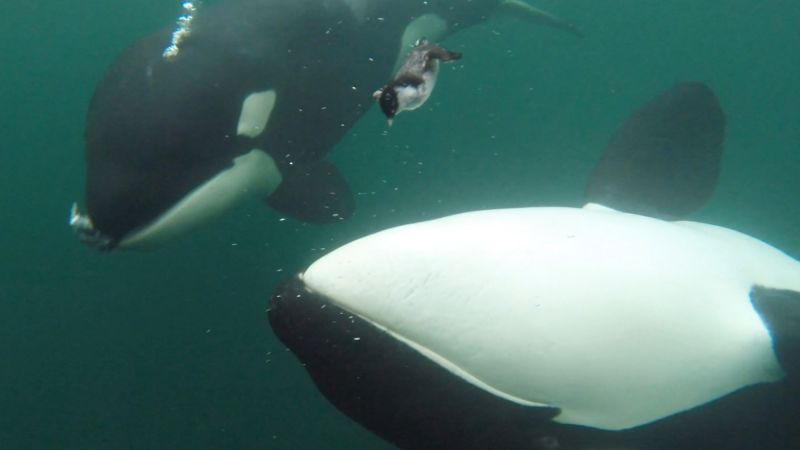In an extraordinary encounter beneath the waves, marine researcher Jared Towers documented a striking behavior in killer whales, providing insights into their intelligence and social behaviors. As he positioned his underwater cameras to observe a duo of orcas, he encountered an unexpected phenomenon: a juvenile female killer whale approached one of the cameras. To Towers’ astonishment, she opened her mouth and let a dead seabird float out. This unique display raised questions about the orca’s motivations and intentions. After pausing momentarily to observe Towers’ reaction, the orca rolled over and consumed the seabird once more, suggesting a complex interaction between humans and these majestic creatures.
The intrigue deepened when, later in his research, Towers witnessed a similar act of sharing from another young female killer whale, who dropped a freshly caught harbor seal pup next to his boat. These events prompted Towers to engage in discussions with fellow marine biologists worldwide, revealing that such “gifts” from killer whales were not isolated incidents. A collaborative effort among researchers led to the identification of 34 separate instances where killer whales presented humans with food between 2004 and 2024.
Their findings were documented in a paper published in the Journal of Comparative Psychology, prompting an exploration into the reasoning behind this unusual behavior. The team considered several hypotheses: perhaps the killer whales exhibited curiosity about human reactions to gifts. Alternatively, the act could stem from a playful instinct, although this theory was largely dismissed due to the involvement of orcas across various age groups, not just juveniles. A more concerning possibility was that these intelligent animals might employ such tactics to lure and potentially attack other species, although it is noteworthy that no evidence of orcas attacking humans in the wild has been recorded.
Towers acknowledged the complexity of the behavior and asserted that pinning it down to a single cause was an oversimplification. “The main underlying mechanism is simply that they can afford to offer us food, and the main proximate cause may be that they are doing so as a way to explore and subsequently learn more about us,” he stated. Notably, in most instances documented, killer whales exhibited a degree of patience, waiting for a response from humans before retrieving the food. Unfortunately, human responses were generally dismissive, with the food being ignored or tossed back into the water on several occasions.
Interestingly, this phenomenon of gifting is not exclusive to killer whales. Pets, too, manifest similar behaviors; for instance, many cat owners are all too familiar with the occasional present of a dead mouse or bird left at the doorstep. Historically, wild predators offering food to humans have been rare, with a scant number of recorded instances involving false killer whales and leopard seals.
Though these gifting behaviors may seem anomalous, Hanne Strager, an esteemed researcher and author of “The Killer Whale Journals,” noted the inquisitive nature of killer whales based on their extensive interactions with humans on the water. “There’s something going on between us and them,” Strager remarked. It is widely recognized that killer whales possess one of the most highly developed brains within the animal kingdom, surpassed only by humans concerning brain size relative to body size. This intelligence allows them to hunt prey significantly larger than themselves, potentially leading to surplus food that can be shared.
Research has also suggested that killer whales possess spindle neurons in their brains, which are linked to empathetic behaviors. Philippa Brakes, a behavioral ecologist specializing in marine mammal behavior, suggested that while determining the motivations behind these behaviors is complex—”because we can’t interview them,” she quipped—the phenomenon could stem from either “altruistic” tendencies or instinctual responses reminiscent of caring for younger dolphins.
Further findings indicated that gifting behaviors were exhibited fairly consistently across demographics; the study found that it didn’t matter if the whale was male or female or whether they were calves, juveniles, or adults—all displayed this intriguing behavior. This pattern of interaction points to an ongoing desire of killer whales to engage with humans further, revealing intriguing aspects of their social structure and biological imperatives.
Towers hopes that this extraordinary behavior will serve as a reminder of our responsibility in cohabitating with other highly evolved species. Despite the advancements of humanity, it is crucial to consider the well-being of these intelligent marine mammals as we navigate our relationship with the ocean and its inhabitants. As humanity continues to confront pressing environmental challenges, initiatives like the Call to Earth, an editorial series by CNN addressing sustainability, remind us of the actions needed to protect our planet and its diverse ecosystems, including the remarkable life forms that inhabit its depths.












